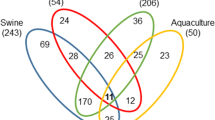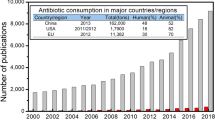Abstract
Animal manure from modern animal agriculture constitutes the single largest source of antibiotic resistance (AR) owing to the use of large quantities of antibiotics. After animal manure enters the environment, the AR disseminates into the environment and can pose a potentially serious threat to the health and well-being of both humans and animals. In this study, we evaluated the efficiency of three different on-farm waste treatment systems in reducing AR. Three classes of erythromycin resistance genes (erm) genes (B, F, and X) conferring resistances to macrolide–lincosamides–streptogramin B (MLSB) and one class of tetracycline resistance genes (tet) gene (G) conferring resistance to tetracyclines were used as models. Real-time polymerase chain reaction assays were used to determine the reservoir sizes of these AR genes present in the entire microbiome. These classes of AR genes varied considerably in abundance, with erm(B) being more predominant than erm(F), erm(X), and tet(G). These AR genes also varied in persistence in different waste treatment systems. Aerobic biofiltration reduced erm(X) more effectively than other AR genes, while mesophilic anaerobic digestion and lagoon storage did not appreciably reduce any of these AR genes. Unlike chemical pollutants, some AR genes could increase after reduction in a preceding stage of the treatment processes. Season might also affect the persistence of AR. These results indicate that AR arising from swine-feeding operations can survive typical swine waste treatment processes and thus treatments that are more effective in destructing AR on farms are required.



Similar content being viewed by others
References
Aarestrup FM, Oliver Duran C, Burch DG (2008) Antimicrobial resistance in swine production. Anim Health Res Rev 9:135–148
Angenent LT, Mau M, George U, Zahn JA, Raskin L (2008) Effect of the presence of the antimicrobial tylosin in swine waste on anaerobic treatment. Water Res 42:2377–2384
Antunes P, Machado J, Sousa JC, Peixe L (2004) Dissemination amongst humans and food products of animal origin of a Salmonella typhimurium clone expressing an integron-borne OXA-30 beta-lactamase. J Antimicrob Chemother 54:429–434
Baquero F, Martinez JL, Canton R (2008) Antibiotics and antibiotic resistance in water environments. Curr Opin Biotechnol 19:260–265
Bibbal D, Dupouy V, Ferre JP, Toutain PL, Fayet O, Prere MF, Bousquet-Melou A (2007) Impact of three ampicillin dosage regimens on selection of ampicillin resistance in Enterobacteriaceae and excretion of bla TEM genes in swine feces. Appl Environ Microbiol 73:4785–4790
Binh CT, Heuer H, Kaupenjohann M, Smalla K (2008) Piggery manure used for soil fertilization is a reservoir for transferable antibiotic resistance plasmids. FEMS Microbiol Ecol 66:25–37
Blake DP, Hillman K, Fenlon DR, Low JC (2003) Transfer of antibiotic resistance between commensal and pathogenic members of the Enterobacteriaceae under ileal conditions. J Appl Microbiol 95:428–436
Chen J, Fluharty FL, St-Pierre N, Morrison M, Yu Z (2008) Technical note: occurrence in fecal microbiota of genes conferring resistance to both macrolide–lincosamide–streptogramin B and tetracyclines concomitant with feeding of beef cattle with tylosin. J Anim Sci 86:2385–2391
Chen J, Yu Z, Michel FC Jr, Wittum T, Morrison M (2007) Development and application of real-time PCR assays for quantification of erm genes conferring resistance to macrolides–lincosamides–streptogramin B in livestock manure and manure management systems. Appl Environ Microbiol 73:4407–4416
De Leener E, Martel A, Decostere A, Haesebrouck F (2004) Distribution of the erm (B) gene, tetracycline resistance genes, and Tn1545-like transposons in macrolide- and lincosamide-resistant enterococci from pigs and humans. Microb Drug Resist 10:341–345
Emborg HD, Vigre H, Jensen VF, Vieira AR, Baggesen DL, Aarestrup FM (2007) Tetracycline consumption and occurrence of tetracycline resistance in Salmonella typhimurium phage types from Danish pigs. Microb Drug Resist 13:289–294
Gilchrist MJ, Greko C, Wallinga DB, Beran GW, Riley DG, Thorne PS (2007) The potential role of concentrated animal feeding operations in infectious disease epidemics and antibiotic resistance. Environ Health Perspect 115:313–316
Goldburg R, Roach S, Wallinga D, Mellon M (2008) The risks of pigging out on antibiotics. Science 321:1294
Iranpour R, Cox HH (2007) Evaluation of thermophilic anaerobic digestion processes for full-scale Class A biosolids disinfection at Hyperion treatment plant. Biotechnol Bioeng 97:19–39
Jindal A, Kocherginskaya S, Mehboob A, Robert M, Mackie RI, Raskin L, Zilles JL (2006) Antimicrobial use and resistance in swine waste treatment systems. Appl Environ Microbiol 72:7813–7820
Koike S, Krapac IG, Oliver HD, Yannarell AC, Chee-Sanford JC, Aminov RI, Mackie RI (2007) Monitoring and source tracking of tetracycline resistance genes in lagoons and groundwater adjacent to swine production facilities over a 3-year period. Appl Environ Microbiol 73:4813–4823
Kolz AC, Ong SK, Moorman TB (2005) Sorption of tylosin onto swine manure. Chemosphere 60:284–289
Koonin EV, Makarova KS, Aravind L (2001) Horizontal gene transfer in prokaryotes: quantification and classification. Annu Rev Microbiol 55:709–742
Luo H, Wan K, Wang HH (2005) High-frequency conjugation system facilitates biofilm formation and pAMβ1 transmission by Lactococcus lactis. Appl Environ Microbiol 71:2970–2978
Mackie RI, Koike S, Krapac I, Chee-Sanford J, Maxwell S, Aminov RI (2006) Tetracycline residues and tetracycline resistance genes in groundwater impacted by swine production facilities. Anim Biotechnol 17:157–176
Martinez JL (2009) Environmental pollution by antibiotics and by antibiotic resistance determinants. Environ Pollut 157:2893–2902
Mathew AG, Cissell R, Liamthong S (2007) Antibiotic resistance in bacteria associated with food animals: a United States perspective of livestock production. Foodborne Pathogens and Disease 4:115–133
Patterson AJ, Colangeli R, Spigaglia P, Scott KP (2007) Distribution of specific tetracycline and erythromycin resistance genes in environmental samples assessed by macroarray detection. Environ Microbiol 9:703–715
Rajic A, Reid-Smith R, Deckert AE, Dewey CE, McEwen SA (2006) Reported antibiotic use in 90 swine farms in Alberta. Can Vet J 47:446–452
Stine OC, Johnson JA, Keefer-Norris A, Perry KL, Tigno J, Qaiyumi S, Stine MS, Morris JG Jr (2007) Widespread distribution of tetracycline resistance genes in a confined animal feeding facility. Int J Antimicrob Agents 29:348–352
Stroman P, Muller CC, Sorensen KI (2003) Heat shock treatment increases the frequency of loss of an erythromycin resistance-encoding transposable element from the chromosome of Lactobacillus crispatus CHCC3692. Appl Environ Microbiol 69:7173–7180
Sunde M, Sorum H (2001) Self-transmissible multidrug resistance plasmids in Escherichia coli of the normal intestinal flora of healthy swine. Microb Drug Resist 7:191–196
Williams CM (2005) Development of environmentally superior technologies: phase 2 report for technology determinations per agreements between the Attorney General of North Carolina and Smithfield Foods, Premium Standard Farms, and Frontline Farmers. Available at http://www.cals.ncsu.edu/waste_mgt/smithfield_projects/phase2report05/phase2report.htm
Witte W (2000) Selective pressure by antibiotic use in livestock. Int J Antimicrob Agents 16:S19–S24
Wolska KI (2003) Horizontal DNA transfer between bacteria in the environment. Acta Microbiol Pol 52:233–243
Yu Z, Michel FC Jr, Hansen G, Wittum T, Morrison M (2005) Development and application of real-time PCR assays for quantification of genes encoding tetracycline resistance. Appl Environ Microbiol 71:6926–6933
Yu Z, Morrison M (2004) Improved extraction of PCR-quality community DNA from digesta and fecal samples. BioTechniques 36:808–812
Zhang XX, Zhang T, Fang HH (2009) Antibiotic resistance genes in water environment. Appl Microbiol Biotechnol 82:397–414
Zhao S, Qaiyumi S, Friedman S, Singh R, Foley SL, White DG, McDermott PF, Donkar T, Bolin C, Munro S, Baron EJ, Walker RD (2003) Characterization of Salmonella enterica serotype Newport isolated from humans and food animals. J Clin Microbiol 41:5366–5371
Zilles J, Shimada T, Jindal A, Robert M, Raskin L (2005) Presence of macrolide–lincosamide–streptogramin B and tetracycline antimicrobials in swine waste treatment processes and amended soil. Water Environ Res 77:57–62
Acknowledgement
The work was partially supported by a USDA-CSREES award (Z.Y. and M.M., 2003-45050-01616) as well as by an OARDC SEED award (Z.Y. and F.M., 2005-OHOA1188).
Author information
Authors and Affiliations
Corresponding author
Rights and permissions
About this article
Cite this article
Chen, J., Michel, F.C., Sreevatsan, S. et al. Occurrence and Persistence of Erythromycin Resistance Genes (erm) and Tetracycline Resistance Genes (tet) in Waste Treatment Systems on Swine Farms. Microb Ecol 60, 479–486 (2010). https://doi.org/10.1007/s00248-010-9634-5
Received:
Accepted:
Published:
Issue Date:
DOI: https://doi.org/10.1007/s00248-010-9634-5




